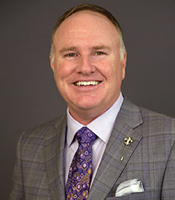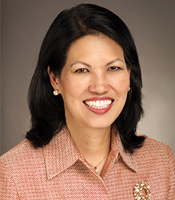
In the midst of a national workforce crisis, finding effective ways to keep the good workers you have can feel like a heavy lift. But one way to take the weight off this challenge is to engage frontline team members in a certified nursing assistant (CNA) apprenticeship program.
 “We know that residents are coming into our facilities with higher acuity and greater demands for customer service. An apprenticeship can help facilities address these challenges,” said Todd Schmiedeler, chief executive officer (CEO), Thumbprint Consulting, in Louisville, Ky. He added, “This creates an avenue where everyone gets in a pathway that helps them grow and become more self-sufficient. It’s about finding out where our CNAs want to go professionally and helping them get there.”
“We know that residents are coming into our facilities with higher acuity and greater demands for customer service. An apprenticeship can help facilities address these challenges,” said Todd Schmiedeler, chief executive officer (CEO), Thumbprint Consulting, in Louisville, Ky. He added, “This creates an avenue where everyone gets in a pathway that helps them grow and become more self-sufficient. It’s about finding out where our CNAs want to go professionally and helping them get there.”
RAP Taps into CNAs’ Potential and Passion to Learn
A CNA registered apprenticeship program (RAP) is a career pathway where individuals obtain paid work experience and classroom instruction through a nationally recognized program. This takes them to a higher level of skills and enables them to obtain specialized training and certification.
Ideally, an apprenticeship not only raises skill levels but also productivity, efficiency, and leadership abilities, thus contributing to greater worker satisfaction and the quality of resident care. A key element of a good apprenticeship is clear wage and career progression. Most commonly, wage increases are tied to the completion of special occupational competencies or program modules. This opportunity to make more money, as well as take on new roles or responsibilities, serves as an incentive for participants.
Individuals who complete apprenticeships often go on to become mentors for new apprentices. Usually, these programs are provided at no cost to the worker, and many also cover related fees and materials. Some also offer a stipend to help participants with childcare or transportation expenses.
RAPs provide training in core competencies to equip participants with the knowledge and experience to serve effectively as a CNA. Additionally, programs may involve advanced competencies in specialty areas (such as palliative or end-of-life care) that apprentices will need for a specific care setting or type of facility. At the same time, RAPs also involve competency training in soft skills such as communicating with residents and staff, managing stressful situations, and leadership skills.
There are numerous national program sponsors and industry intermediary groups that offer RAPs. The key, suggested Schmiedeler, is finding one that has conducted apprenticeships for health care and understands the long term care setting.
One advantage of having an RAP is that you are eligible for funding to support the development and expansion of RAPs. For instance, the Department of Labor (DOL) recently announced the Apprenticeship Building America Grant Program, offering a total of $113 million to pay for worker apprenticeship programs. Grant applications were due on April 25, 2022, and awards notifications are pending.
LaShuan Bethea, NCAL executive director, and AHCA’s senior director of not-for-profit and constituent services Dana Ritchie are pleased to announce that AHCA/NCAL has entered into a partnership with a group called Equus Workforce Solutions for offering long term care apprenticeship programs for our state affiliates and/or provider members that are interested. Bethea and Ritchie noted that, “AHCA/NCAL is excited to be collaborating with Equus to support the development and expansion of RAPs that can positively impact our members and those they serve in the future. The partnership will help to encourage more to enter the long term care field.”
Michelle Day, National Workforce Solutions Director, is leading up this partnership for Equus and noted “Under contract with the DOL, Equus serves as an Industry Intermediary and National Apprenticeship Program Sponsor. Our team provides technical assistance to support the development and expansion of RAPs with a focus on the health care industry. As a comprehensive provider of workforce development services, Equus is uniquely positioned to connect career seekers to apprenticeship opportunities.”
More Than a Flyer
“We think sometimes that if we communicate something through a flyer, people know about it. But that’s not enough to help CNAs understand how an apprenticeship benefits them and their residents,” said Schmiedeler.
Sherry Perry, board chair of the National Association of Health Care Assistants (NAHCA) and a long-time CNA, agreed, “How the apprenticeship program is introduced makes a difference.” For instance, she suggested it’s important for CNAs to understand that while the apprenticeship is about career advancement and upskilling, it doesn’t mean they have to go back to school and/or become a nurse. An apprenticeship, she said, would be attractive for CNAs who love their jobs but would like to advance in this role and have more opportunities as part of the clinical team.
Perry stressed that the apprenticeship must result in real opportunities after CNAs complete it. “Everyone on the team needs to know what an apprenticeship is and what it means. CNAs who complete the program must feel that they are more respected and have new opportunities that they didn’t have before.
You can’t just do it for appearances.” Also remember, she noted, that other CNAs will be watching what happens. “They will be paying attention. They need to see the positive impact of the apprenticeship programs on CNAs who go through it. If they don’t see any impact or benefits, they won’t see it has a genuine attempt by the facility to invest in and lift up CNAs.”
Schmiedeler said, “Thought leadership is often underrated, but it can make a powerful difference.” If a CNA who is respected and looked up to by others goes through the program and can say it makes a difference, more are likely to embrace it. He explained, “Their energy translates to other people.” At the same time, he said, “You need to look beyond general communication. Everyone’s invitation is no one’s invitation if it doesn’t make you feel special.”
Establish the criteria for participation up front, Perry suggested, adding, “Be transparent about who is eligible, what will be expected of them, and what they will get from the program. Start with your long-term people, those who stood by you during challenging times. Don’t just start with new people and forget your veterans.”
The RAP in Action
 The RAP is an important career ladder that gives CNAs an opportunity to climb to heights they didn’t have access to before. As Tina Sandri, CEO of Forest Hills of Washington, D.C., said of her organization’s program, “We are trying to career-ladder our CNAs to be leaders and connect them with the necessary educational resources.” She added, “Sometimes in life it’s not easy getting to that next step, and we need a nudge. This is a nudge to get our CNAs to the next rung of education if they so desire.”
The RAP is an important career ladder that gives CNAs an opportunity to climb to heights they didn’t have access to before. As Tina Sandri, CEO of Forest Hills of Washington, D.C., said of her organization’s program, “We are trying to career-ladder our CNAs to be leaders and connect them with the necessary educational resources.” She added, “Sometimes in life it’s not easy getting to that next step, and we need a nudge. This is a nudge to get our CNAs to the next rung of education if they so desire.”
Forest Hills partnered with Suma Prime School of Healthcare, in collaboration with the D.C. Department of Employment Services, to build an apprentice program. In addition to receiving an industry-recognized credential that meets both D.C. and national standards, graduates also will receive encouragement, support, and connections to resources to further their education and pursue Licensed Practical Nurse (LPN) and Registered Nurse (RN) careers. Forest Hills received grant funds from D.C. Healthcare Career Advancement Program to jumpstart the program. Sandri said, “About 70 percent of the program is online, and the rest is onsite. The focus is on retention.”
Sandri so believes in the apprenticeship program and the importance of investing in CNAs that she and her organization recently applied for an Apprenticeship Building America grant to build an apprentice program that every nursing home in D.C. can take advantage of and to build training programs around the city. They also have applied for an AARP grant aimed at fostering resiliency within the workforce.
“Resiliency is low hanging fruit in terms of getting staff to stay. People are committed but tired, and we are trying to find ways to boost their resilience and keep them from burning out.” In addition to the incremental pay bumps, she suggested, there are other ways facilities can encourage and incentivize CNAs to participate in and complete apprenticeships, such as offering scholarships.
Sandri admits that launching an apprenticeship program can be challenging. With budgets tight, it’s not always easy to find money for such endeavors. She said, “That is why we are chasing grants. But if you watch your tips and insights from AHCA, stay alert for various funding opportunities, and are prepared to roll up your sleeves, it can be done.”
Is it worth it? Sandri thinks so. She said, “The principle of encouraging the best and brightest is basic. How can you afford not to? We hear from our staff that pizza parties and other efforts are nice but that we need to do more. We need solutions that make people feel heard, appreciated, and valued on a deeper, more sustained level.” She further noted, “The biggest metric we are going after is decreased turnover rate. The apprenticeship is a promising strategy. When we have such programs designed to support, engage, and empower our teams, outcomes are better. While there isn’t enough data to link this directly to apprenticeships, we do know that low turnover yields better results, and these programs can help us do that.”